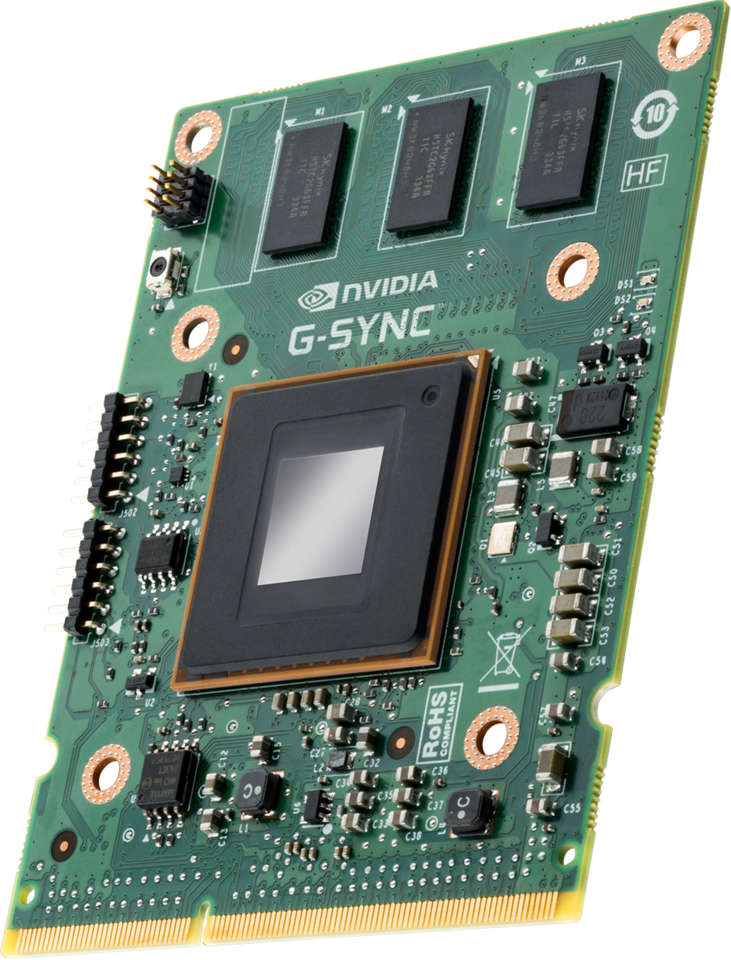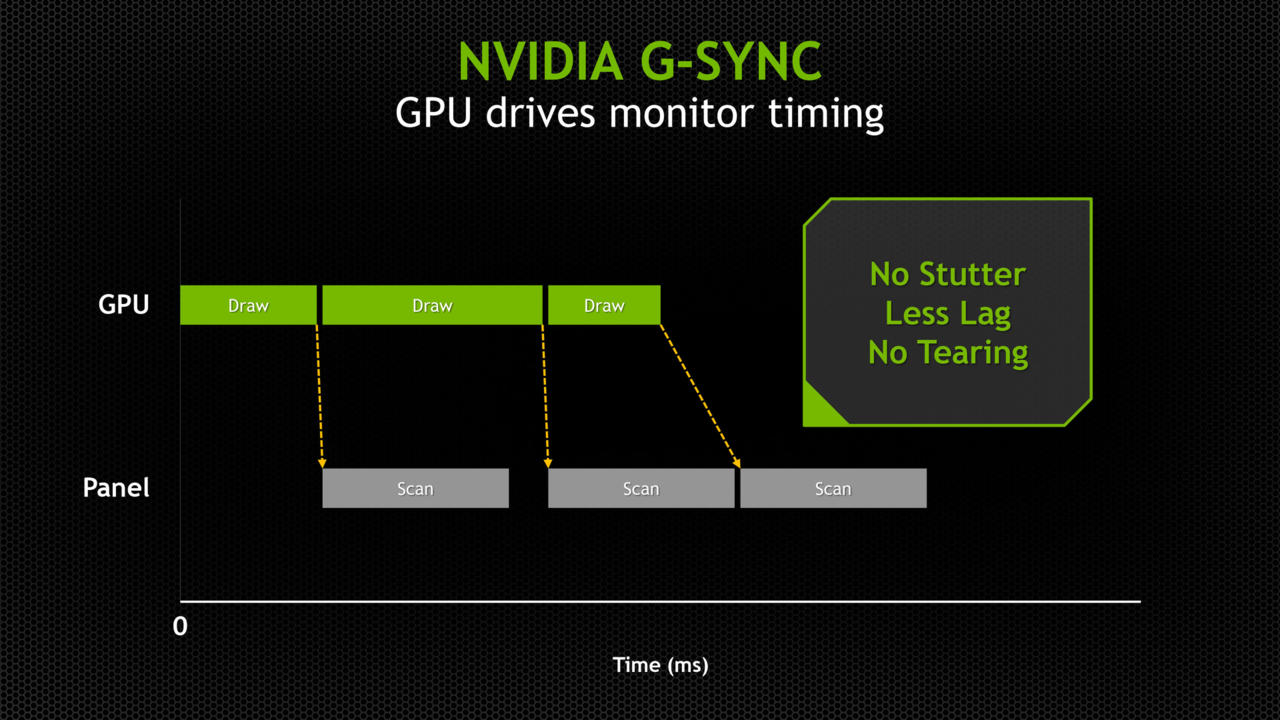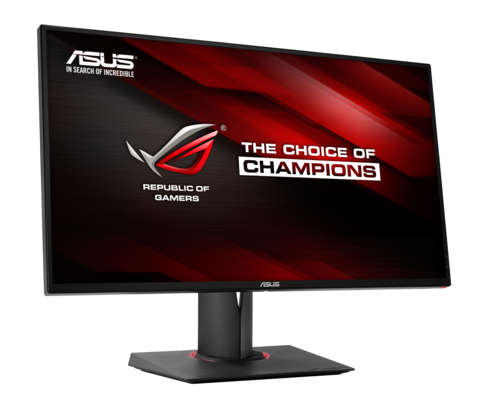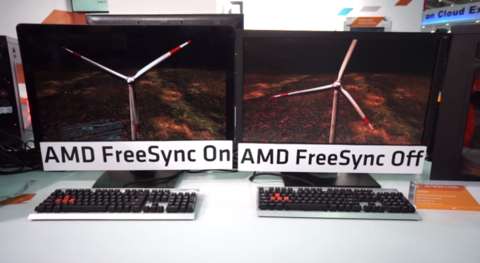"Faster equals better" is how you'd normally think about improving a gaming PC. A new CPU, gigabytes of RAM, and a more powerful GPU (not to mention the swift response times of an SSD) all give you some sort of boost in frame rates and image quality, resulting in an arguably better experience. But with its G-Sync technology, Nvidia is giving the PC crowd another option, one that absolutely transforms the way your games look, play, and respond.
Why Do I Need G-Sync?

Traditionally, PC monitors and TVs update at a fixed refresh rate. Typically, this is 60Hz, meaning that the image displayed is updated 60 times a second; some gaming-specific monitors offer even higher refresh rates of 120Hz, or 144Hz. The higher the refresh rate of the monitor, the smoother an image appears in motion. In an ideal world, the frame rate of a game would perfectly match up with the refresh rate of a monitor, resulting in a smooth image free of any artefacts. The trouble is, GPUs aren't really designed that way, and instead try to render frames as quickly as possible, presenting them to the display when they're done.
This creates some of the more common issues that tend to affect the visual quality of games. For instance, if your GPU spits out a frame in the middle of a display's refresh cycle (this typically happens when the game is rendering frames faster than the monitor can display them), it ends up showing part of the image from one frame and part of the image from another at the same time, resulting in what's commonly known as screen tearing. The fix for this is to keep the GPU and display in sync with V-Sync. With V-Sync on, the GPU only passes frames to the display when it's ready for them. This eliminates tearing, but causes another problem: stuttering.
It's incredibly difficult for a game render at a consistent frame rate, simply because each frame of that game can be very different from the one that proceeded it. In a shooter, you might have noticed that during indoor sections, the frame rate is much higher than in big outdoor sections where there's lots of different elements to render. This variable frame rate means that even with V-Sync on, the GPU still wants to present a frame that's out of sync with the display. If that frame arrives before the display is ready, the GPU waits until next refresh period, resulting in a repeated frame in the interim, which makes the image appear to stutter.
Aside from being visually distracting, stuttering also has the effect of increasing input lag as the GPU repeats frames in order to keep itself aligned with the refresh rate of the monitor. That's why you often see professional players turning off V-Sync, and making do with lots of screen tearing.
How Does G-Sync Work?
Nvidia's solution to the problem is simplicity itself, so much so that it's a wonder that it's taken this long for a company to release it. There's no real technical reason that modern LCD displays update at a fixed refresh rate, other than that they were first designed to replace CRT displays, which only work at fixed refresh rates. Nvidia eliminates this hangover from the CRT days by replacing the scaler from a monitor with a G-Sync one, enabling a variable refresh rate that waits until the GPU is ready with a new frame before displaying the image. The result is a wonderfully smooth image that's free from tearing and stuttering, even at sub 60fps performance.

At a technical level, the G-Sync module works by manipulating a display's VBLANK (vertical blanking interval), which is the time between the display drawing the last line of the current frame and drawing the first line of the next frame. During this VBLANK, the display holds the current frame before beginning to draw a new one. VBLANK is yet another hold over from CRTs, where a gap was needed in order for the CRT to begin drawing a frame from the top of the display (CRTs draw frames from top to bottom). Modern LCDs don't actually need VBLANK, but Nvidia found a new use for it, modifying the VBLANK time so that the display can wait for a new frame from the GPU before displaying it, resulting in a variable refresh rate.
I'll Need Some New Gear, Right?
Of course, this being an Nvidia solution, you need an Nvidia GPU to make it work, as well as a special G-Sync display. While G-Sync has been around for a while, it's only recently that retail G-Sync displays have become available, commanding a significant price premium (around $200) over their non-G-Sync counterparts. However, nearly all G-Sync monitors (with the exception of Acer's 60Hz 4K panel) run at high 144Hz refresh rates, and sport very low latency times, making them ideal for playing games. The cheapest in the US right now is BenQ's XL2420G, a 24" 1080p display that retails for $599 [UPDATE: AOC's G-SYNC G2460PG 1080p monitor is currently available for $499 at Best Buy], while those in the UK can check out the AOC G2460PG, which retails for around £329.

The absolute best of the bunch right now is the 27" ASUS ROG PG278Q, a 1440p display that retails at a hefty $799. As I noted during my GTX 980 review, 1440p is the sweet spot for high-end gaming right now, with smooth 60fps visuals possible with just a single GPU (although two definitely won't hurt!). Aside from sporting one the of the thinnest bezels I've seen on a monitor, the ASUS ROG PG278Q also features a 144Hz panel, as well as a 1ms response time. The only downside with the display is that it makes use of a TN panel (albeit a very good one), which means you don't get the same ultra-wide viewing angles and colour reproduction of a good IPS panel.
Acer's $799 XB280HK is a tempting option for those wanting to get into 4K (particuarly given the sub 60fps performance of running games in 4K) but you do have to make do with a TN panel that only goes up to a 60Hz refresh rate. Whichever G-Sync monitors you go for, there are some limitations to be aware of, namely that all of them only feature a single display port input. This is thanks to G-Sync only working over display port, and the module only allowing for a single input. On the plus side, a G-Sync display will happily work with any display port enabled device, just without any of the frame-syncing goodness.
Sounds Good, But Does G-Sync Actually Work?
The difference between a G-Sync display and a non-G-Sync display is dramatic, although, it largely depends on what kind of performance you're getting from a game in the first place. Anything below 30fps results in the same kind of stuttering that you see with V-Sync turned on, so don't expect miracles if you're running older hardware (note that G-Sync requires a GTX 650 Ti or higher to work). It's also worth noting that if your system typically manages to run games close to the refresh rate of your monitor, you won't initially notice much difference between V-Sync and G-Sync.
Even then, there's still an advantage to running G-Sync. With it switched on (running on a the ASUS ROG PG278Q in this case), there's no screen tearing at all, while stuttering is completely eliminated. The difference is night and day, and I've never played games that looked and felt as smooth as they do while using G-Sync. Going back to V-Sync (on or off) further highlights the improvements of G-Sync, with games looking awfully juddery without it. Given the current niche nature of G-Sync, it's unlikely you'll be able to head down to your nearest electronics store to check it out and see the differences for yourself, but trust me when I say that $200 monitor markup is more than worth it.

That's particularly true if you're running games at higher resolutions (1440p and up), or with all the settings cranked up. With G-Sync, it's not as important that your game runs at a fixed 60fps frame rate, for which you'd typically have to turn down some settings, or invest in better graphics hardware. I found that anything from 35fps and up looked fantastic on G-Sync, with none of the noticeable fluctuations in frame rate that you'd get from a regular monitor. Even if you're fortunate enough to have a system that regularly pushes above 60fps at 1440p, I found the 144Hz refresh rate of the ASUS monitor still made a big difference to the smoothness and response time of games.
What About Freesync?
Not long after Nvidia took the wraps off G-Sync, AMD unveiled Freesync, its own version of the technology. The key difference between the two is that Freesync has been developed in conjunction with VESA (the Video Electronics Standards Association), which integrated a technology called Adaptive-Sync into Display Port 1.2a standard as an optional feature. Oddly, Adaptive-Sync has been part of VESA's embedded DisplayPort standard (eDP being used for things like connecting internal graphics cards to notebook display panels) since 2009, with the tech primarily aimed at reducing power consumption by playing with VBLANK timings. Only recently has Adaptive-Sync been extended to the desktop.

The trouble is, there aren't actually currently any Adaptive-Sync/Freesync monitors on the market. While the standard itself is free for any monitor maker to use (and for any GPU or hardware maker to integrate at their end), the monitor itself still needs a specialised scaler in order to handle the variable refresh rate. With G-Sync, Nvidia created the scaler and sold it on. Adaptive-Sync/Freesync requires monitor makers to create their own scalers, which obviously costs quite a bit in R&D. That said, AMD recently announced it would be collaborating with MStar, Novatek and Realtek to build suitable scalers, although, the company didn't mention availability, or how much it would cost manufacturers to use.
So far, the only displays confirmed to make use of Freesync come from the mighty Samsung and LG. Samsung's consist of the 23.6" and 28" UD590, and the 23.6", 28", and 31.5" variants of the UE850, all of which will be UHD (4K) displays, while LG has a 21:9 1440p curved display on the way. Only Samsung's Freesync displays have a release date, though, and are due to land this March. Because Adaptive-Sync is an open standard, there's nothing to stop Nvidia from making its GPUs compatible with Display Port 1.2a and thus Samsung's variable fresh rate monitors, or any others that get released. Given the amount of R&D that's gone into G-Sync, that's not likely to happen any time soon, but if Adaptive-Sync take off in a big way, the company may not have a choice.
As it stands though, Adaptive-Sync/Freesync has only been seen in tech demo form. If you want to experience to joys of variable frame rates right now, G-Sync is the only option.
Verdict
The smoothness that G-Sync brings to games can be astonishing at times. Once I'd experienced games without the stutter and screen tearing that have come to be part and parcel of a gaming experience (particularly on PC), I found it very hard to go back. Even better is how G-Sync enabled me to crank up all the settings without worrying about hitting a minimum of 60fps. That's a big deal not just for players, but for developers that often have to fight against visual fidelity in order to reach a minimum frame rate target. Sadly, there's no word on whether G-Sync will make its way to TVs anytime soon, and thus perhaps into future consoles (it'd be useful for 24fps Blu-Ray movies too). Right now, it's a PC-only solution, but one that's well worth the cost. And hey, with the likes Steam, 60fps, and 4K, only available to PC players, might as well have another reason way to make the PC awesome right?
